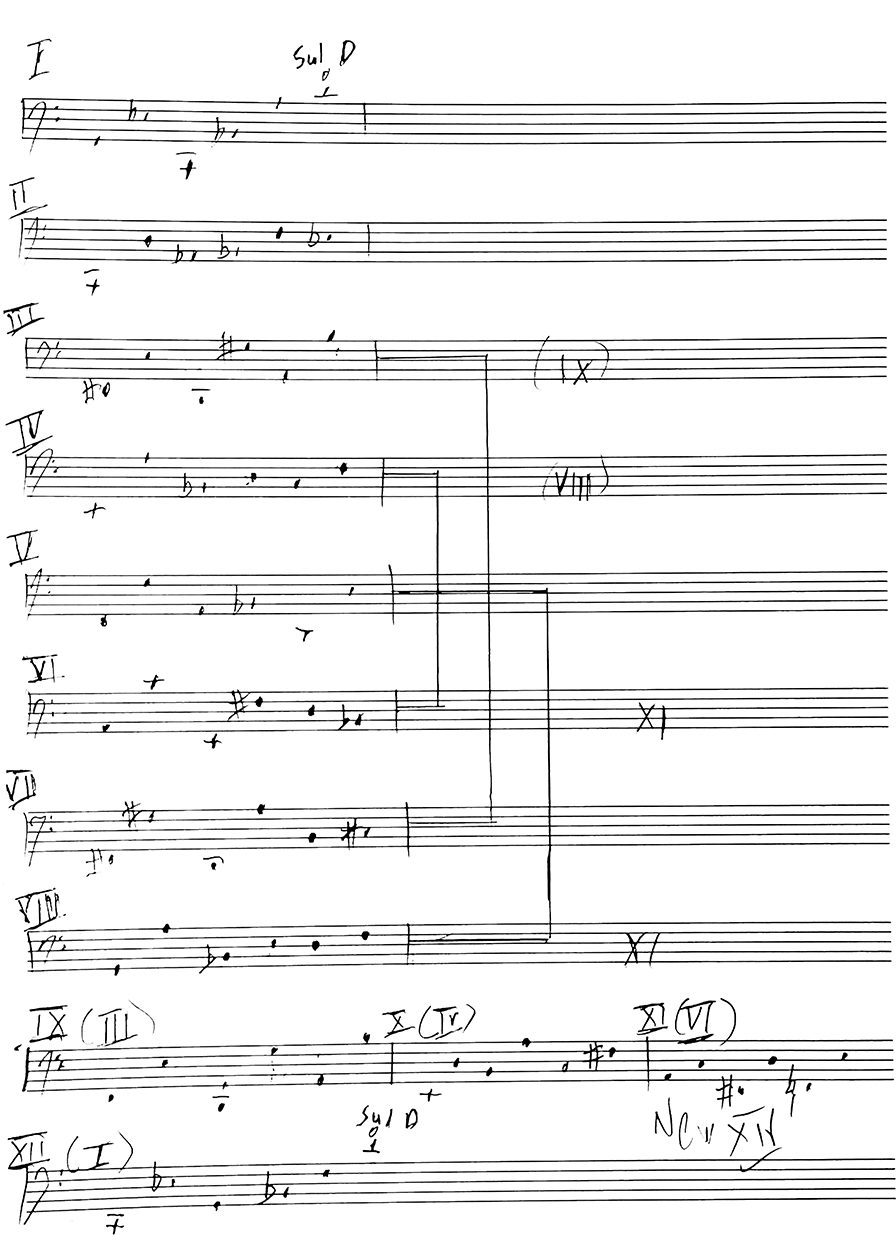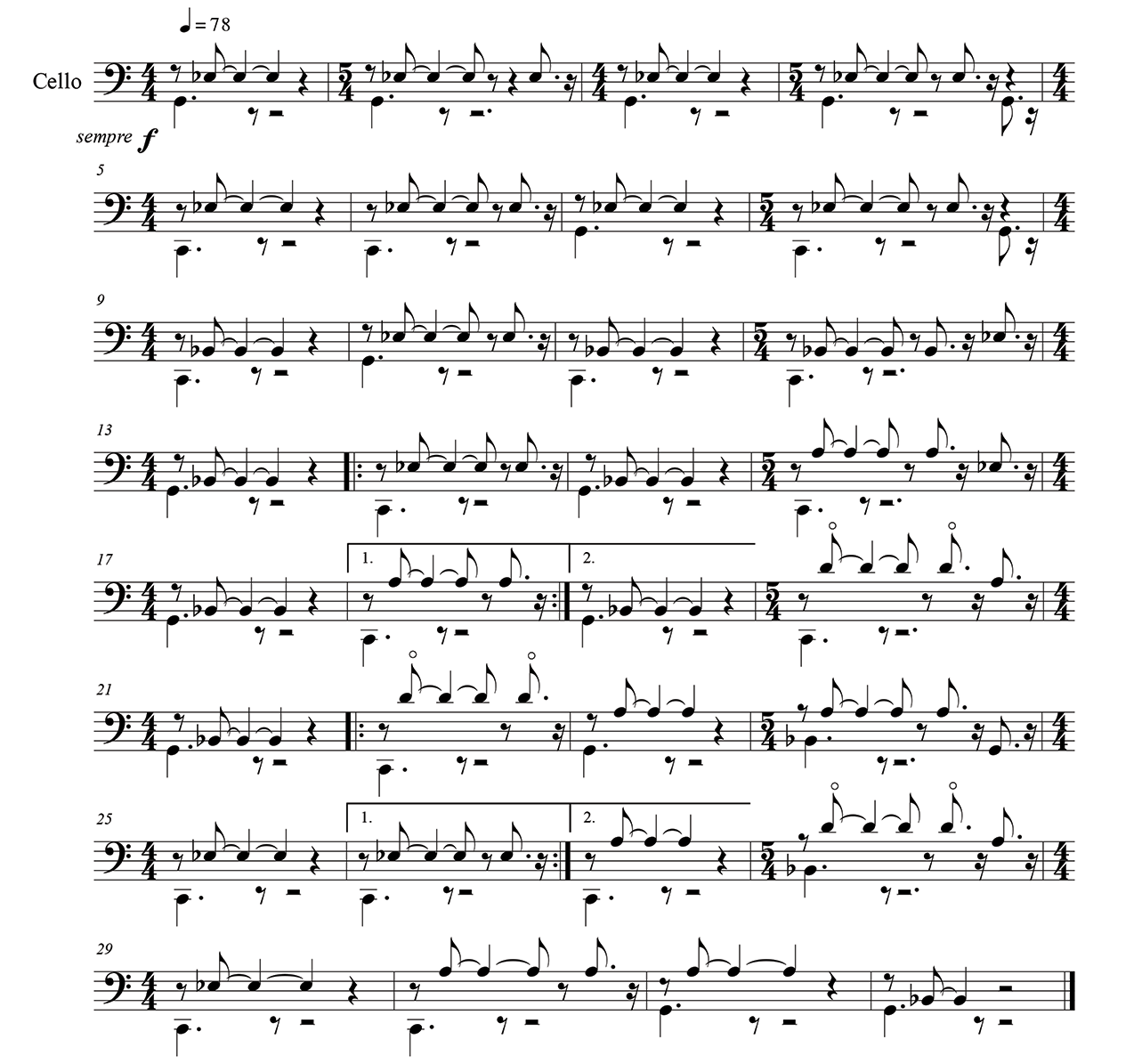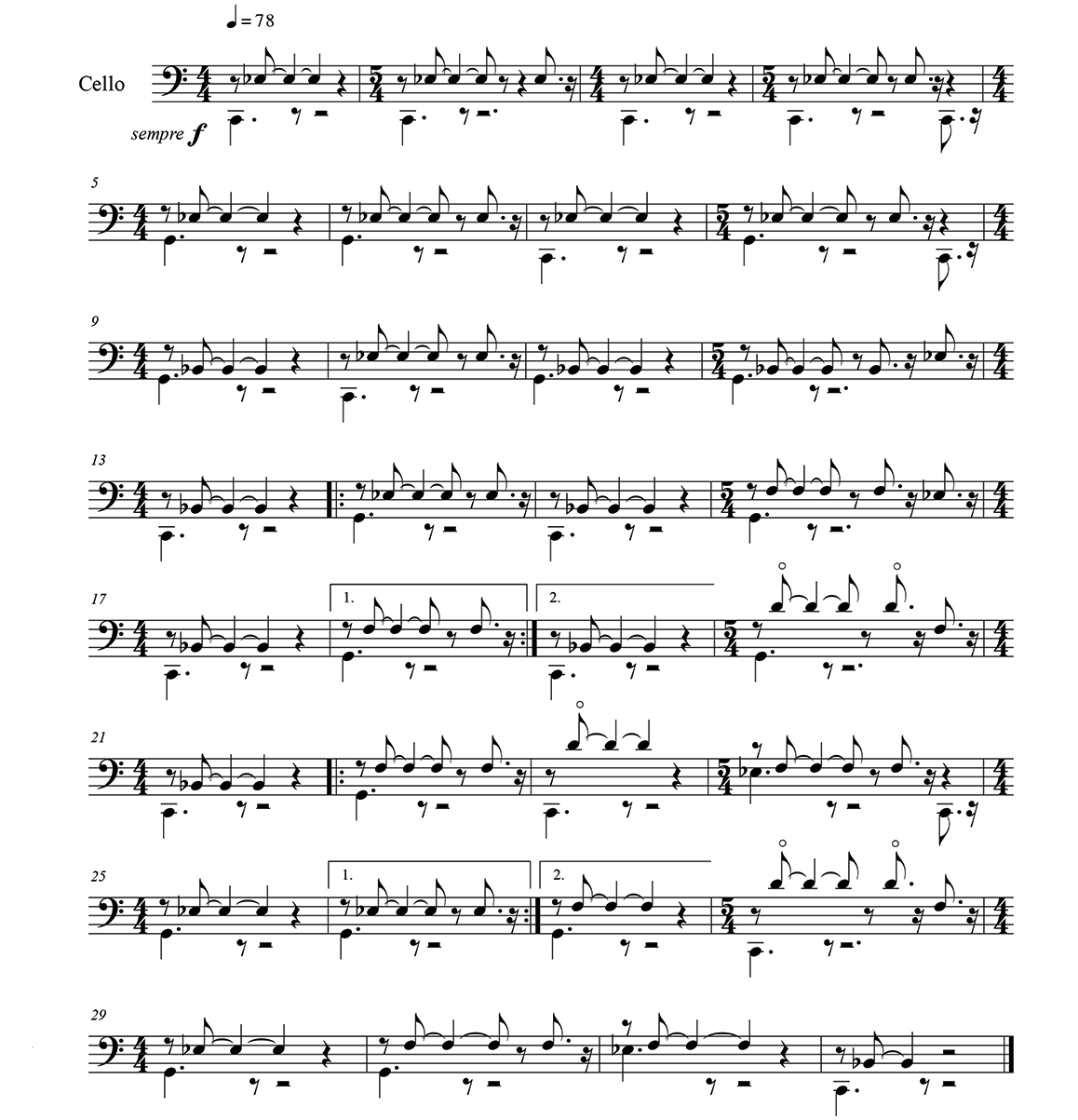Cello Music
Music for Cello
The six pieces for solo cello contained in this anthology were written or revised between the years of 2008 and 2020. The works represent several distinct approaches to writing for the instrument and to composition in general. The 4 CD format was chosen because it provides the listener the best opportunity to approach each work within the singular aesthetic context from which it was created.
Form and Style
Despite the stylistic variances in this collection, the pieces share an important commonality, fixed pitch location. This a compositional technique whereby once a pitch is used at a given register in a piece, for example A4 or the A above middle C, that pitch is ‘fixed’ at that register for the remainder of the piece. All the cello pieces in this album employ this device. The aim of such an approach is to radically reduce pitch material within a composition to a well-defined set of points. In doing so the potential harmonic/melodic impact of a single pitch on any of the other pitches is exponentially intensified, undiluted by octave displacements which alters its original intervallic correlations within the series. Thus, from the opening notes of a composition the musical event horizon is overdetermined by concentrating into a single fixed-pitch set all possible musical outcomes.
Volume One
Paul Christopher – Rehearsal for RESONANCE
University of Louisiana, Monroe
RESONANCE
Groups II, III
RESONANCE
Group IV
RESONANCE for Solo Cello (2013)
Paul Christopher – Cello
RESONANCE was the first composition to utilize groups as a largescale organizational tool. Each of the five groups that comprise the piece contains its own fixed-pitch set.
Group I is divided into three sections, each characterized by a different texture.
In Group II the movement’s lyricism provides a contrast to the dramatic opening and serves as a bridge to Groups III and IV.
The central body of RESONANCE is built around two related groups. Group III is the most concentrated movement in the piece wherein each fixed pitch is assigned its own dynamic as well as mode of attack.
The fixed pitches of Group IV are also assigned specific dynamics and modes of attack; however, these are varied from the previous movement.
The longest movement of the piece, Group V begins with a single line cast unwaveringly in tempo. The group develops with the pulsed notes increasingly interrupted by recurring single pitch points set in contrasting tempos. As the points accumulate their apposition to the pulse notes form a time polyphony within a complex system of imbedded repeats. The temporal layers become increasingly intertwined before unraveling and collapsing into a single, concluding pitch.
KAFKAMUSIK Suite for Solo Cello (2014, rev. 2019)
Carole Rabinowitz – Cello ᶜ
Paul Christopher – Cello ᴾ
The KAFKAMUSIK Suite is a programmatic instrumental cycle based upon the writings of Czech-born, German-language writer Franz Kafka. Part I of the Suite is scored for clarinet, violin, guitar, and cello. The five pieces for solo cello make up the second half of the suite.
Kafka wrote “The Stoker” as the opening chapter of his first novel Amerika. In it, a young man is sent by boat from his home country in Europe to America. The music reflects his initial impressions of the frenetic pace of the new world as the slow-moving ship arrives in New York.
“Report to an Academy” is the account of a narrator speaking at an academic conference, of his former life as an ape. The lyrical setting for cello suggests the incongruity of the story’s premise.
“Description of a Struggle” is one of Kafka’s earliest works. Comprised of three discrete chapters the structure of the story is fragmented. The music follows the broken narrative set in three rapidly alternating sections, interrupted by a static caesura in harmonics before the closing recapitulation.
Consisting of only a few sentences, “Absent-Minded Window Gazing” is one of Kafka’s shortest works. The pointillistic cello setting mirrors the terseness of the text.
“A Hunger Artist” is considered one of Kafka’s finest works. The eponymous central character sits alone in his bare cage on display at a circus. His capacity for unremitting fasting is a performance art that only he understands. The music explores the opposing themes of isolation and public spectacle.
Deidre Emerson – Premiere Music for Cello III
Washington and Lee University, Lexington City, VA
Music for Cello I
Deidre Emerson – Cello
Music for Cello is an ongoing series of pieces written for solo cello. Currently there are five works in the collection. The overriding structure of the cycle unfolds as a series of schematic imprints; a design whereby a composition’s formal structure is repeated or imprinted in successive pieces.
Music for Cello 1 consists of 5 sets of fixed pitches divided into 5 groups. The individual groups are related by pitch juxtapositions and real-time correlations. Groups I and V, which share the same the same fixed-pitch set, serve as the principal foundation for the inner movements. Groups II, III, and IV contain their own fixed-pitch sets with group III subdivided into two juxtaposed sets of five and seven. The structure of each of the 5 groups in Music for Cello 1 is then imprinted and repeated in Music for Cello 3 and Music for Cello 5; however, the corresponding individual pitch sets vary slightly.
MUSIC FOR CELLO Group II
Carole Rabinowitz – Cello
Cast in seven sections, Music for Cello 2 is also comprised of 5 fixed-pitch sets but has a different overall structure than Music for Cello 1, 3, and 5. In Music for Cello 2, group III, comprised of two fixed-pitch sets, is divided into five sections, and dispersed throughout the piece. Although the shortest movement, group III’s periodic appearance lends the work a distinct formal design. The structure of each of the 5 groups in Music for Cello 2 is then imprinted and repeated in Music for Cello 4 with slight variances in the corresponding pitch sets.
MUSIC FOR CELLO Group III
Deidre Emerson – Cello
In the Music for Cello 3 imprint, the pitch range contracts in groups I, II, and IV as compared to the Music for Cello 1 scheme. However, in groups III and IV the range is expanded. The individual pitch sets in each group vary slightly from Music for Cello 1.
MUSIC FOR CELLO Group IV
Deidre Emerson – Cello
Of all the pieces in this series, Music for Cello 4 stands apart in several important ways. First, it is not a direct schematic imprint of Music for Cello 2. There are subtle alterations in the original structure as well as slight metric changes that recur throughout. As well, the cyclical occurrence and rhythmic variance of Group III provides the piece with an air spontaneity and unpredictability.
MUSIC FOR CELLO Group V
Deidre Emerson – Cello
The pitch range in the Music for Cello 5 schematic imprint remains the same as # 3 in groups I, IV, and V. The range of groups II, and III are contracted from the same groups as Music for Cello 3. The individual pitch sets in each group vary somewhat from those in Music for Cello 1 and 3.
Music for Cello I
Group IV
Mark Prince Lee - Recording of RESONANCE
First Avenue Sound Studio, Franklin, TN
RESONANCE
Recorded 2012
First Avenue Sound, Franklin, TN
Engineered by David Hall
Additional recording by Brad Bass
KAFKAMUSIK Suite
Recorded 2013
First Avenue Sound, Franklin, TN
Engineered by David Hall
Additional recording by Brad Bass
Music for Cello I, III, IV, V
Recorded 2018
Uno Mas Studio, Brentwood, TN
Engineered by David Hall
Music for Cello II
Recorded 2015
First Avenue Sound, Franklin, TN
Engineered by David Hall
All titles mixed by David Hall, mastered by Benny Quinn
All works composed by Mark Prince Lee
Produced by Mark Prince Lee
© 2022 Leerstelle Music
Volume Two
Compression Pt. I
Fixed Pitch Groups I-XII
Compression Pt. I
Group I
Compression Pt. I
Group XII
Compression Pt. I (2018 – 2019)
Deidre Emerson – Cello
Compression for solo cello makes up Part I of the four-part instrumental cycle for clarinet, viola, and cello by the same name. Divided into twelve groups, each movement of Part I consists of 6 fixed pitches set over 40 measures, with a duration of 2’ 14” each.
The overriding structure of Compression for solo cello evolves as a series of schematic imprints; a design whereby a composition’s formal structure is repeated or imprinted in successive pieces.
Group I is divided into three sections of 13, 21, and 6 measures, respectively. Measures 1 through 13 introduce the first four fixed pitches and establish the opening structural scheme in three 4 measure blocks punctuated by a single block in measure 13. The final two fixed pitches appear in the central and longest section of the piece organized around two internal repeats. The final six measures freely recombine the 6 fixed pitches and close the group. The 40-measure design of Group I is then imprinted and repeated in Groups II through XII.
The 12 discrete, 6-note, fixed-pitch groups of Compression for cello are all derived from the opening group, and arranged into two blocks of six. All 12 fixed-pitch groups share a correlated intervallic relationship, providing the work a distinct and cohesive harmonic ambiance. However, the intervallic sequence between the 6 pitches in any group is never repeated within the course of the piece.
3R (1985, rev. 2018)
Radiate Pt. IV / 2R (1986, rev. 2019 – 2020)
Paul Christopher – Cello
3R and 2R are composed utilizing a large-scale organizational structure referred to as a region. Just as groups are used as a tool in organizing individual movements within a work-as applied in Resonance, Music for Cello, and Compression Pt. I-3R and 2R are comprised of broad, temporal zones termed regions.
The internal construction of 3R and 2R is generated by dynamic form. In opposition to the role of imbedded repeats or schematic imprints whose internal systems are built around repetition, dynamic form resists reiteration and operates as a multi-directional open form, precipitous and unpredictable in its development. In this process, the musical event horizon is perpetually external to work’s structure, proximate but inaccessible. The arrangement of individual lines, layers, blocks, and rapid pulse formations within the large-time regions of 3R and 2R represents but one compositional outcome within an array of potential realizations.
3R for solo cello is set in 3 discrete regions. A single 12-note fixed-pitch set is used throughout the piece. (Two very brief transpositions occur in the first and third regions.) Region I is organized by five separate tempos in the form of a measured accelerando. Divided into two parts, each section begins with a long, single, sustained pitch. The function of Region I within 3R is twofold. First, it introduces, one at a time, the notes of the fixed-pitch set. More importantly however, the slow introduction outlines the region’s internal boundaries in the form of time blocks, which are developed and assembled as individual lines, or in layers.
The closing bars of Region I metrically elide into Region 2, also organized by a series related tempo changes. The work’s central area, characterized by block chords, explores the harmonic relationships within the fixed-pitch set. The intervallic juxtapositions between notes are cast in vertical groupings of 2, 3, and 4 notes, freely mixed in a variety of durations.
The closing bars of Region 2 metrically elide into Region 3, divided by tempo into two subsections. The concluding area of the piece is organized by linear pitch blocks of varying duration, occurring in rapid succession with periodic alterations in tempo. As the internal concentration within the blocks increases, they build and accumulate before finally dispersing into the work’s concluding, sustained chords.
3R Structural Design by Tempo (All Metronome Values are at the Quarter Note)
Region I
52 – 54 – 57.5 – 63 – 70
Region II
70 – 78.5 – 92 – 108 – 59.5
Region III
59.5 – 45
2R serves as Part IV of the instrumental cycle Radiate for alto flute, bass clarinet, percussion, violin, and cello. The piece is organized around four parameters: pitch, tempo, dynamics, and mode of attack. These parameters play an important role in the work’s formal design.
Pitch – A primarily chromatic, 12-note fixed-pitch set serves as the basis for Part IV of the cycle. As 2R unfolds, 10 of the pitches are transposed up, one at a time, one or two octaves until the piece concludes with a repositioned 10-note set.
Tempo – The piece contains four primary tempos, each assigned to one of four dynamics: ff, f, mf, pp. One of the tempos with corresponding dynamics is also assigned to one of two specific modes of attack. A basic quarter note pulse of 54 is used for the molto sul tasto sections throughout the piece. However, the molto ponticello sections are expressed as a proportion of the basic pulse which changes as the piece develops.
Structural design – 2R is formally organized into two broad regions dividing the piece into two approximately equal halves. Region I is temporally centered around a quarter note pulse of 86. Region II is centered around a quarter note pulse of 72. Throughout 2R, the two base tempos and mode of attack tempos are intermingled, frequently interrupted by sporadic, metric subdivisions which emerge as a temporal sub-structure. The differing sections are fractured into layers and juxtaposed with increasing irregularity. Oppositional segments assimilate into contrapuntal time blocks where they cease to follow any discernable linear course, creating a friction in the time-flow of the piece. In the central section of the second region the individual segments begin to unravel, and the time polyphony disperse. 2R closes with a final distillation of these disparate elements into a single musical unity expressed in the concluding lines of the piece.
Compression Pt. I
Recorded 2019-2020
Uno Mas Studio, Brentwood, TN
Engineered and mixed by David Hall
3R
Recorded 2019
Mr. Luke’s Recording House, Natchitoches, LA
Engineered by Luke Brouillette
Mixed by Roger Barnes and Paul Christopher
Radiate Pt. IV / 2R
Recorded 2020
Mr. Luke’s Recording House, Natchitoches, LA
Engineered by Luke Brouillette
Mixed by Luke Brouillette and Paul Christopher
All titles mastered by Benny Quinn
All works composed by Mark Prince Lee
Produced by Mark Prince Lee
© 2022 Leerstelle Music









